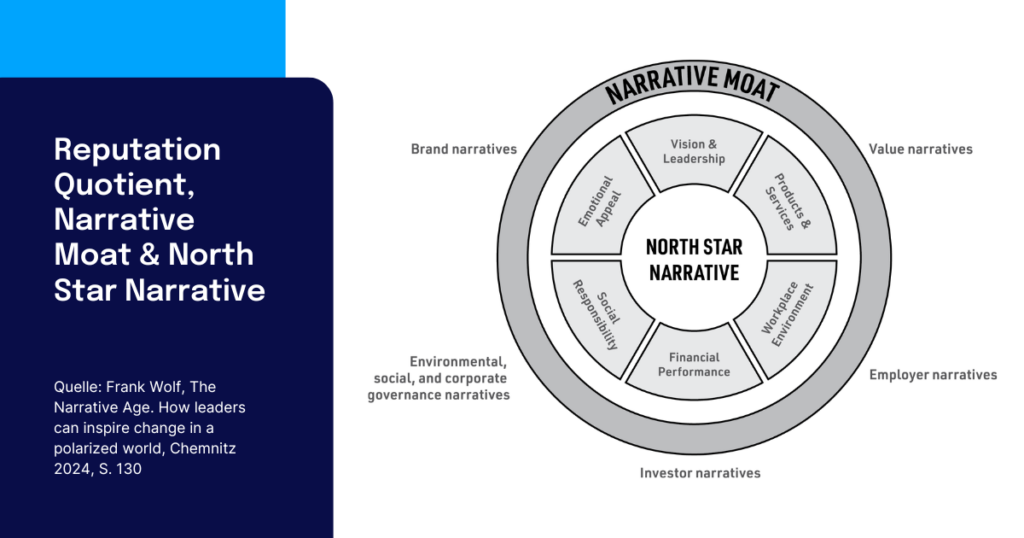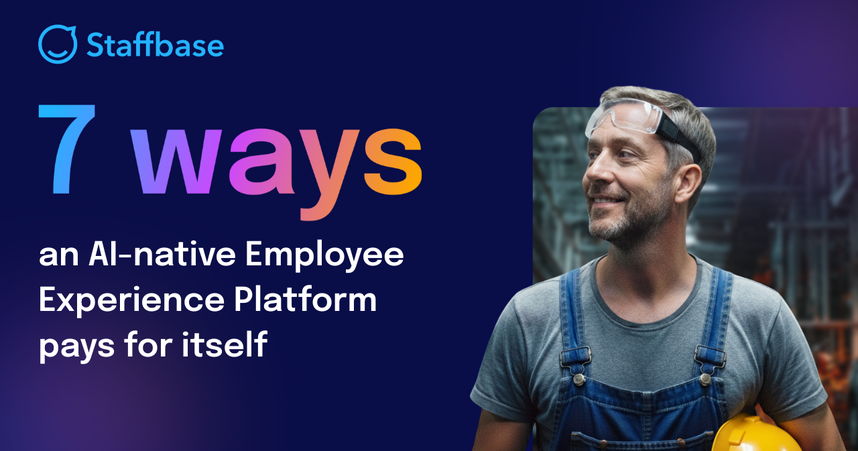From tool sprawl to flow: How an AI-native EX platform simplifies work
Tool sprawl drains attention and slows transformation. Discover how an AI‑native employee experience platform turns scattered tools into a coherent journey.

Tool sprawl drains focus and slows decisions by scattering information across overlapping, unconnected tools; frontline workers feel the impact most.
An AI-native employee experience (EX) platform connects your existing HR, IT, and comms systems into one governed entry point — no rip-and-replace — so people can find, understand, and act faster.
Data readiness comes first: clear ownership, regular audits, and feedback loops prevent AI from amplifying errors.
The platform tackles three core issues — change communication that reaches everyone, time lost to switching/searching, and declining trust — through targeting, orchestration, and validated content.
Where Staffbase fits: the Staffbase Employee Experience Platform unifies intranet, app, email, and screens with an AI layer that validates, routes, and personalizes updates to turn tool sprawl into flow.
Introduction to tool sprawl
Remember that great feeling when you found the perfect new app?
I once found a brilliant little tool to solve a very specific problem in my project management workflow — only to realize a few months later that half the teams around me had found their own brilliant little tools. Suddenly, nobody knew where anything lived anymore.
This is the curse of tool sprawl: too many apps, too little alignment, and no shared source of truth.
With over two decades in B2B SaaS, I’ve seen the same productivity killer in many organizations I’ve worked with; when information isn’t consistent across tools, everything slows down. Teams burn hours jumping between systems to piece together the full picture. Managers can’t keep messaging aligned. And the people who need clarity the most — frontline employees — are the ones most likely to miss critical updates.
But what if you could have all the power without the chaos? The good news is you don't need a massive, expensive "rip-and-replace" project. You just need a single, intelligent entry point that manages access and delivers clarity.
Welcome to the impact of an AI-native employee experience platform. It reduces friction by connecting the systems you already rely on — something I’ve seen dramatically improve communication flow across large, distributed teams. When it’s implemented well, it becomes a single, reliable entry point for employees, eliminating the constant switching between disconnected tools and making information easier to find, understand, and act on.
In this guide, you’ll learn:
What tool sprawl is and why it slows work, especially for frontline teams.
How an AI-native EX platform works and how it connects your existing systems without a rip-and-replace project.
Why data readiness matters more than AI readiness and the governance gaps most organizations overlook.
The three core problems an AI-native EX platform solves — from change communication to wasted time and eroding trust.
Practical steps you can start this quarter, with examples, patterns, and a concise FAQ.
And don’t worry — as the Chief Operating Officer at Staffbase, I’ll be breaking things down every step of the way. Let’s explore how you can go from tool sprawl to flow and improve the digital employee experience for all workers.
What is “tool sprawl” — and why does it matter?
There’s a good chance you’ll recognize the elements of tool sprawl even if you aren’t familiar with the term. Essentially, tool sprawl is the organizational accumulation of too many IT and software tools, often with overlapping functions.
Imagine a massive kitchen junk drawer that’s overflowing with everything from ancient takeout menus to aged sugar packets. Consider it like this:
The drawer: Your entire workplace or digital environment.
The tools: The apps, systems, and software your company invests in.
The sprawl: It's so full that things are scattered, you have five different pens (competing tools), none of the batteries work (unconnected systems), and you can never find the one thing you actually need (no shared context).
The bottom line: You spend more time digging than doing.
Ultimately, tool sprawl can slow down execution and decision-making. It’s the often overlooked cost of productivity that makes work harder for everyone. In fact, it’s reported that as much as 74% of IT teams use fragmented toolchains.
📍Quick Definition: Tool sprawl = too many apps, unconnected systems, competing sources of truth, and no shared context.
Why tool sprawl is a productivity barrier
Tool sprawl doesn’t happen overnight; it’s the result of teams trying to solve immediate problems without a shared, long-term strategy. Over time, these disconnected tools begin to compete rather than collaborate, creating invisible friction across every department. And there’s data to back these claims.
A Barracuda Networks survey polled 2,000 senior security decision-makers in IT and finance/business roles — in the US, UK, France, DACH, Benelux, the Nordics, Australia, India, and Japan — and found that 80% reported that integration issues increase time needed to manage security, with 81% reporting this led to higher costs.
Plus, tool sprawl poses a significant threat to defense, particularly hindering detection (77% reporting) and complicating threat mitigation (78% reporting).
Here’s how tool sprawl damages the digital employee experience:
Lost productivity: Employees waste hours switching between platforms, logging in repeatedly, or searching for information scattered across channels.
Duplicate work: Multiple teams build the same resources or reports in different tools — without realizing it.
Broken communication loops: Messages get missed because people rely on different apps, leaving frontline or remote workers out of sync.
Inconsistent data: Conflicting versions of “the truth” make decision-making slower and riskier.
Low adoption and ROI: Even great tools fail if employees are overwhelmed or unsure where to go — driving down engagement and wasting investment.
Security risks: The more disconnected tools, the harder it becomes for IT to manage permissions, integrations, and compliance.
What is an AI‑native EX platform?
 Now that we’ve unpacked tool sprawl, let’s look at what comes next: the shift toward an AI-native employee experience platform, a modern approach that finally brings scattered tools, channels, and processes into one connected flow.
Now that we’ve unpacked tool sprawl, let’s look at what comes next: the shift toward an AI-native employee experience platform, a modern approach that finally brings scattered tools, channels, and processes into one connected flow.
In our own organization, we saw this problem up close. Employees often had to navigate complex Jira forms just to request something simple, such as tool access, a purchase, or a legal review. They needed to understand workflows that honestly shouldn’t matter to them.
Now the burden shifts away from the employee thanks to our AI-native EX Platform. The system behaves like a co-worker: it answers questions directly when it can, and when it can’t, it quietly creates and routes the right ticket in the background. No forms, no guessing, no friction. For employees, the complexity disappears. They now get solutions instead of ticket numbers.
At its core, an AI-native EX platform uses trusted data, connected systems, and governed AI to personalize, validate, and route information and services across the employee journey. It doesn’t replace your existing tools — it connects them. This makes work simpler, faster, and more human.
But here’s an important distinction: your platform can be AI-native; your employee experience cannot.
Employee experience will always be human. It’s the sum of every moment that shapes how people feel about their work, their leaders, and their ability to thrive — from their first interview to their last day. No technology can replace that.
What AI can do is reduce the friction around those moments. It can facilitate, clarify, and streamline the operational parts of work to free teams to focus on what matters most: building trust, connection, and the conditions for people to do their best work.
Key capabilities of an AI-native EX platform
Conversation as the interface: Employees can ask for information or services in natural language — “How do I request time off?” — and get instant, accurate responses.
Validated content at scale: AI helps keep information consistent, compliant, and aligned with brand standards across every channel.
Deep personalization: The experience adapts to each person’s role, location, schedule, and preferences — so employees only see what’s relevant to them.
Orchestration: AI automates key moments that matter — like onboarding, policy updates, or leadership announcements — ensuring every employee gets the right message at the right time.
📍Quick Definition: AI-native employee experience platform = a connected, intelligent system that uses governed AI to simplify communication, personalize the employee journey, and make work flow.
What makes an AI-native EX platform unique
Many platforms today offer AI capabilities, but that doesn’t automatically make them AI-native. An AI-native EX platform is one where AI isn’t an afterthought — it’s woven into how information flows, how employees find what they need, and how systems work together. Here’s what that means in practice:
A single, connected entry point — not a collection of tools. Most EX setups grow over time, leading to separate apps, channels, and portals. An AI-native EX platform unifies them into one front door to work, where HR, IT, and communications systems connect, and employees get a consistent experience.
AI that orchestrates — not just adds convenience. This isn’t about AI writing drafts in the background. It’s about using governed AI to validate information, guide employees to the right place, personalize updates, and keep communication aligned across every channel.
Personalization that adjusts to every role, location, and shift. Employees don’t have to sift through noise. An AI-native EX platform adapts what people see based on who they are, where they work, what they need, and when they need it — without increasing workload for internal teams.
Governance is embedded into the foundation. Accuracy checks, audit trails, controlled sources, and AI guardrails ensure employees always see the latest, approved information. This reduces confusion and strengthens trust across the workforce.
No rip-and-replace required. Becoming AI-native doesn’t mean rebuilding your entire stack. It means connecting your existing HRIS, ITSM, and operational systems more intelligently — reducing friction and making the tech you already have work better together.
Finding a strategic North Star
 Before you modernize your employee experience, you need a clear North Star — a simple, shared definition of what “good” looks like. Here’s how to find it:
Before you modernize your employee experience, you need a clear North Star — a simple, shared definition of what “good” looks like. Here’s how to find it:
1. Start with outcomes, not tools.Don’t anchor your strategy in apps or features. Ask: What should employees be able to do faster, easier, or with more confidence?
2. Map the moments that matter.Identify the key points in the employee journey — onboarding, shift start, policy changes, crisis updates. Your North Star should guide how each moment becomes clearer and more consistent.
3. Create a narrative everyone can use.A strong narrative acts as your filter. For example: “One entry point, one experience.” If an initiative doesn’t support it, it’s not a priority. As my coworker Frank Wolf puts it: A North Star is a narrative you can execute — and that narrative guides every decision.
4. Build the ecosystem around clarity.Data governance, channel strategy, content ownership — they all serve the North Star. When tools compete or duplicate effort, the narrative helps you choose what stays, what integrates, and what goes.
5. Measure real progress.Track whether employees find information faster, complete tasks with fewer steps, and understand changes more clearly. Your North Star becomes stronger every time you measure against it.
Before you can be AI-ready, you have to be data-ready
Before we continue, it’s important to make a quick distinction. Everyone wants to be “AI-ready.” But here’s the truth: most organizations aren’t even data-ready yet.
In conversations with digital workplace, HR, and comms leaders, one theme comes up again and again — getting insights from data takes far longer than it should. The reason? The data that fuels AI is often incomplete, inconsistent, or just plain wrong. The main issues include:
Incomplete employee records and missing attributes in HR systems
Duplicated or outdated content in communication channels
Scattered meeting notes, missing transcripts, or untagged updates
Conflicting versions of “official” information across tools
It’s not just user error. It’s a governance gap.
In my own work with GTM and Ops teams, I’ve seen how often leaders spend more time debating numbers than solving problems, simply because core data like customer records, meeting notes, even basic attributes, is incomplete or inconsistent, and any AI built on top of that only amplifies the errors.
Poor usability, unclear ownership, and a lack of feedback loops make it impossible to keep data clean or current. The result: leaders spend meetings debating metrics instead of driving outcomes — and AI models trained on that same messy data amplify the problem. Wrong data, wrong insights, wrong focus.
That’s why data governance is not bureaucracy — it’s clarity. It’s about knowing who owns what, setting review cycles, and building accountability for accuracy. Each function, from HR to IT to Communications, needs:
Data stewards who maintain quality and structure.
Regular audits to identify broken fields and duplicates.
Feedback loops so errors spotted by AI or dashboards are corrected at the source
Clean data speeds up decisions. Governance builds confidence. And when your data foundation is strong, your AI — and your employee experience — get smarter every day.
📍 The bottom line: AI can only be as intelligent as the data it learns from. If you want an AI-native EX platform that truly simplifies work, start by creating the clarity your data — and your people — deserve.
3 workplace challenges an AI-native EX platform can remedy
 By acting as an intelligent front door, an AI-native EX platform cuts through the clutter to address three key organizational challenges: it drives effective organizational change, eliminates tool sprawl, and delivers valuable AI for every single employee. Let’s explore exactly how this will support your organizational goals.
By acting as an intelligent front door, an AI-native EX platform cuts through the clutter to address three key organizational challenges: it drives effective organizational change, eliminates tool sprawl, and delivers valuable AI for every single employee. Let’s explore exactly how this will support your organizational goals.
Challenge 1: Brilliant strategies fail if they don’t land clearly with every employee.
One of the biggest challenges workplaces face is ensuring messaging reaches every employee. It’s long been reported that as much as 80% of the workforce is deskless. And these are positions where fast access to accurate information and updates doesn’t just mean clarity — it could save lives.
For example, the third annual Safety Culture Feedback from the Field report found that an estimated 77% of Australian workers believe that workplace injuries could have been prevented with better training. Meanwhile, 75% of frontline workers polled rated safety as more important than higher earnings, emphasizing the importance of accurate information and safety guidelines.
An AI-native EX platform addresses frontline communication needs by closing the gap between the executive suite and the frontline. It allows information to be published once and automatically be distributed throughout the workforce, saving time and guaranteeing consistent communication. Such platforms also use smart targeting by role, location, and shift. That means updates land only where relevant, ensuring essential messages are never missed.
In my own teams, I’ve seen how even important changes in onboarding, forecasting, or customer workflows didn’t land consistently with frontline teams simply because communication went through different channels or reached them too late.
Such a system directly stimulates change by empowering managers, who are the key link to organizational transformation. It enables them to receive resources such as hyper-personalized manager toolkits triggered by the organizational change itself — complete with pre-vetted talk tracks, templates, and FAQs.
Meanwhile, an AI-native EX platform provides AI quality control for change comms, implementing guardrails for tone and policy alignment before anything is published. The result? Every employee feels informed, every manager is equipped, and the entire organization moves in sync.
Challenge 2: Employees waste valuable time searching through unconnected apps.
It’s no secret: wasted time is a major productivity cost — and tool sprawl is a huge culprit. An OpenText survey found that due to data silos, 41% of US employees reported an average of one or more hours per work day searching through company systems for work files and critical information. Meanwhile, out of the surveyed US workers, 76% said information overload directly contributes to daily work stress.
An AI-native EX platform remedies this grievance by acting as the single, intelligent navigation system for the entire digital workplace. It becomes the "front door" to people, content, and services, not just a set of static pages.
This can be achieved by utilizing data and integrations with the existing HRIS, ITSM, and operational systems. This integration doesn't mean ripping and replacing your systems of record; it means bringing simple tasks and forms into one place, making life easier for employees without disrupting the core architecture.
The magic happens with the human- and generative AI-powered experiences. In practice, we’ve seen employees rely more on conversational search when information is clearly structured and sourced. Intelligent search and answers are instantly delivered, citing trusted, on-brand sources.
In my observations, even simple tasks like finding the right HR policy or the latest CS playbook required jumping through multiple systems, and people lost minutes every time, which adds up very quickly across hundreds of employees.
The AI can even automate multi-step processes through simple automated journeys for common needs like onboarding or benefits enrollment. This system ensures every piece of information is relevant, accurate, and readily accessible, transforming the technology landscape from a headache into a high-functioning asset.
Challenge 3: Information is everywhere — but trust in it is eroding.
Modern workplaces don’t suffer from a lack of communication — they suffer from a lack of confidence in it. Employees are flooded with messages, updates, and new tools, but they don’t always trust that the information they receive is accurate, timely, or relevant.In fact, the 2025 International Employee Communication Impact Study published by Staffbase and YouGov found that just 9% of non-desk employees are “very satisfied” with internal communication — and 38% rate the communication quality as “only fair” or “poor.”
There is also an alarming gap in frontline communication. The study found that 29% of non-desk employees are very (9%) or rather satisfied (20%) with the quality of internal communication. Meanwhile, around 47% of desk-based employees are very (14%) or rather (34%) satisfied with the quality of internal communication.
An AI-native EX platform helps rebuild that trust. By validating content before publication, aligning tone and policy through AI quality checks, and routing information through governed, integrated channels, it ensures every update employees see is both credible and consistent.
It also provides transparency into how and why information is shared — giving employees more clarity and leaders more control. With this foundation of trust, communication becomes not just noise, but a driver of culture, performance, and engagement.
Key benefits of an AI-native EX platform
 An AI-native employee experience platform isn’t just another layer of technology — it’s the layer that makes everything work together. It creates a single, connected experience that helps employees find what they need, act faster, and stay aligned, no matter where they work.
An AI-native employee experience platform isn’t just another layer of technology — it’s the layer that makes everything work together. It creates a single, connected experience that helps employees find what they need, act faster, and stay aligned, no matter where they work.
Here’s why it matters for every organization:
One front door to work: Employees no longer have to jump between apps or systems. With one intelligent entry point, they can search, ask, or act — getting verified answers and completing tasks in seconds.
Momentum in change: When communication flows clearly through a unified system, adoption happens faster. Leadership messages reach everyone at once, managers follow through more consistently, and employees understand not just what’s changing — but why it matters.
Equity across the workforce: Frontline employees make up about 80% of the global workforce, yet they often get disconnected or receive delayed updates. I’ve seen organizations improve their frontline communication by consolidating updates, using targeting, and distributing content through mobile, app, SMS, or shared screens.
Risk reduction: Governed AI and built-in content validation ensure employees always see the latest, approved version of policies, documents, and announcements. That means fewer errors, less confusion, and stronger compliance.
Integration-ready: No need for a “rip-and-replace” overhaul. An AI-native EX connects to your existing HR, IT, and communication systems — creating flow instead of friction.
How an AI-native EX platform benefits all departments
Really want to make the business case for an AI-native employee experience platform? It creates value across the entire organization — from the boardroom to the frontline. That’s why it’s worth exploring how it benefits all departments.
Executive leadership
Executive leadership will gain clearer visibility into transformation progress and cultural alignment across the company. With consistent, transparent communication flowing to every level, leaders can be confident that strategy is not just shared — it’s understood, adopted, and driving measurable change.
People & culture
The people and culture department leaders will be able to strengthen engagement and retention by giving managers the tools to communicate with clarity and empathy. HR gains early insight into sentiment trends, helping prevent burnout, reduce turnover, and foster a stronger sense of belonging across all teams.
Digital transformation leaders
For digital transformative leaders, an AI-native EX will simplify the tech landscape by reducing fragmentation and integrating systems through a secure, governed AI layer. IT gains back time and control with better data quality, stronger compliance, and transparent, responsible AI deployment across the digital workplace.
Internal communications
Internal comms leaders will be able to deliver more consistent, high-quality messaging across every channel — with real-time insights into what resonates. Communication teams can adapt quickly, improve trust, and build a transparent feedback loop that turns messaging into measurable engagement.
Operations & frontline leadership
Lastly, operations and frontline leadership will finally be able to reach and support every employee, regardless of location or shift. Mobile, app, SMS, and digital signage channels make it easy to share critical updates instantly — keeping frontline teams informed, connected, and confident.
Where Staffbase fits: delivering the ultimate AI-native EX Platform
In every organization I’ve supported, the same pattern shows up: employees don’t struggle because they lack tools; they struggle because those tools don’t work together. Information lives in too many places, context breaks, and clarity suffers.
That’s the problem we’re solving with the Staffbase Employee Experience Platform. Over the years, we’ve built a foundation designed to actually reach every employee, whether they’re desk-based or frontline, global or local. Today, we’re strengthening that foundation with an AI-native approach that brings structure, governance, and intelligence to the entire communication ecosystem.
Our platform unifies intranet, employee app, email, and digital signage into one connected front door. The AI layer doesn’t “add features”; it improves reliability. It validates content, routes information, personalizes updates, and ensures that what employees see is consistent, trusted, and aligned, no matter where they work.
That’s the real impact of an AI-native EX platform — not more technology, but more coherence.
Ready to see how a platform can transform your communication? Book your Staffbase demo now!



